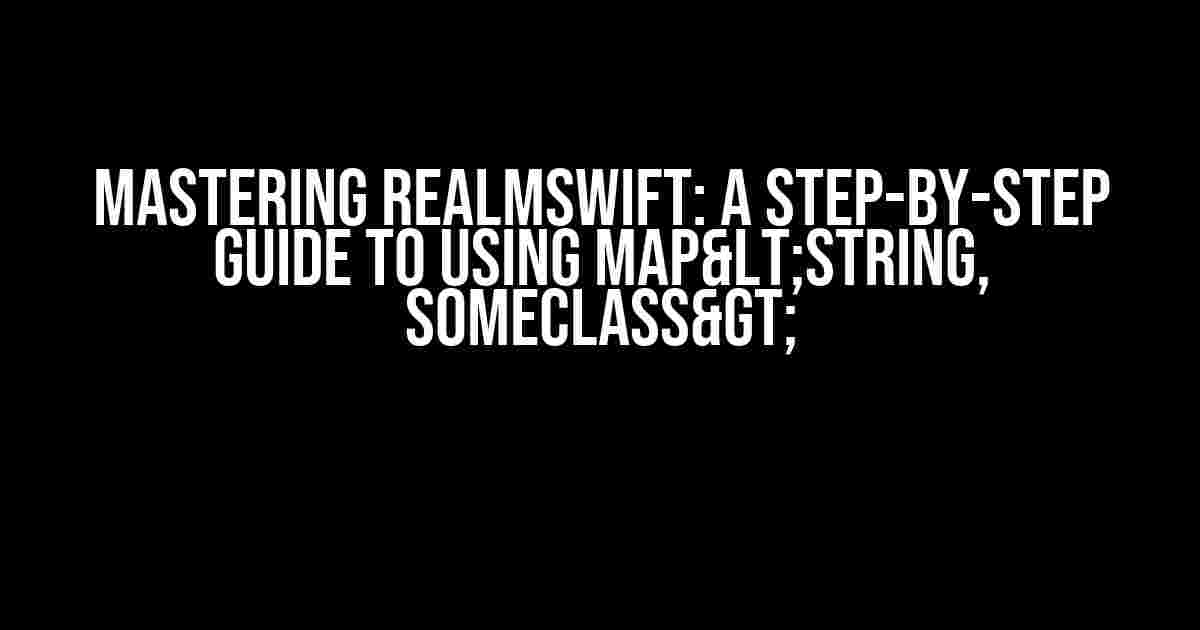Are you tired of dealing with complex data structures in your iOS app? Do you struggle to store and retrieve data efficiently using RealmSwift? If so, this article is for you! In this comprehensive guide, we’ll dive into the world of RealmSwift and explore the wonders of using Map<String, SomeClass> to simplify your data management.
What is RealmSwift?
Before we dive into the world of Map<String, SomeClass>, let’s quickly cover the basics of RealmSwift. RealmSwift is a popular mobile database solution that allows you to store and manage data in a relational database. It’s designed to be fast, efficient, and easy to use, making it a popular choice among iOS developers.
What is Map<String, SomeClass>?
Map<String, SomeClass> is a powerful data structure in RealmSwift that allows you to store a collection of key-value pairs. In this case, the keys are strings, and the values are instances of SomeClass. Think of it like a dictionary, where each key is unique and maps to a specific value.
Why Use Map<String, SomeClass>?
So, why would you want to use Map<String, SomeClass> in your RealmSwift app? Here are some compelling reasons:
- Faster Data Retrieval**: With Map<String, SomeClass>, you can quickly retrieve data using a unique key, making it perfect for caching or storing frequently accessed data.
- Efficient Data Storage**: Map<String, SomeClass> allows you to store complex data structures in a compact and efficient manner, reducing memory usage and improving performance.
- Simplified Data Management**: By using a Map, you can simplify your data management tasks, such as inserting, updating, and deleting data.
Creating a Map<String, SomeClass> in RealmSwift
Now that we’ve covered the basics, let’s get started with creating a Map<String, SomeClass> in RealmSwift! Here’s a step-by-step guide:
- Define Your SomeClass**: First, you need to define the SomeClass that will be stored in the Map. This can be any custom class that conforms to the RealmSwift Object protocol:
- Create a Realm Instance**: Next, create a Realm instance to store your data:
- Define Your Map**: Now, define your Map<String, SomeClass> using the RealmSwift Map type:
class SomeClass: Object {
@objc dynamic var id = UUID().uuidString
@objc dynamic var name = ""
@objc dynamic var age = 0
}let realm = try! Realm()let map = Map<String, SomeClass>()Inserting Data into the Map
Now that we have our Map defined, let’s insert some data into it! Here’s how you can do it:
func insertData.intoMap() {
let someObject = SomeClass()
someObject.name = "John Doe"
someObject.age = 30
try! realm.write {
map["johnDoe"] = someObject
}
}Retrieving Data from the Map
Once you’ve inserted data into the Map, you can easily retrieve it using the key:
func getDataFromMap() {
if let someObject = map["johnDoe"] {
print("Name: \(someObject.name), Age: \(someObject.age)")
} else {
print("No data found for key 'johnDoe'")
}
}Updating Data in the Map
Updating data in the Map is just as simple. Just retrieve the object using the key, update the values, and write the changes to the Realm instance:
func updateDataInMap() {
if let someObject = map["johnDoe"] {
try! realm.write {
someObject.age = 31
}
}
}Deleting Data from the Map
Deleting data from the Map is also straightforward. Just use the key to retrieve the object and then delete it from the Realm instance:
func deleteDataFromMap() {
if let someObject = map["johnDoe"] {
try! realm.write {
realm.delete(someObject)
}
}
}Bonus: Using Map<String, SomeClass> with RealmSwift Lists
Did you know that you can also use Map<String, SomeClass> with RealmSwift Lists? Here’s an example:
class MyClass: Object {
@objc dynamic var id = UUID().uuidString
let someList = List<SomeClass>()
let someMap = Map<String, SomeClass>()
// ...
}In this example, we’ve defined a MyClass object that has a List of SomeClass objects and a Map of String keys to SomeClass values. This allows you to store complex data structures and relationships efficiently.
Conclusion
In this article, we’ve covered the basics of using Map<String, SomeClass> in RealmSwift. We’ve explored the benefits of using Maps, created a Map, inserted data, retrieved data, updated data, and deleted data. We’ve also touched on using Maps with RealmSwift Lists to store complex data structures.
By mastering the art of using Map<String, SomeClass> in RealmSwift, you’ll be able to build more efficient, scalable, and maintainable iOS apps. So, the next time you’re faced with a complex data management task, remember to reach for the power of Maps!
| RealmSwift | Map<String, SomeClass> |
|---|---|
| Fast and efficient data storage | Stores key-value pairs with string keys and custom class values |
| Easy data management | Simplifies data insertion, retrieval, and deletion |
| Scalable and flexible | Supports complex data structures and relationships |
I hope you enjoyed this article! If you have any questions or need further clarification on using Map<String, SomeClass> in RealmSwift, feel free to ask in the comments below.
Frequently Asked Question
Get answers to your questions about using Map<String, SomeClass> in RealmSwift!
Q: Can I use Map<String, SomeClass> in RealmSwift?
Yes, you can use Map<String, SomeClass> in RealmSwift, but it’s not a straightforward process. You need to make sure that SomeClass is a RealmSwift Object and has a primary key.
Q: How do I define a Map<String, SomeClass> in RealmSwift?
You can define a Map<String, SomeClass> in RealmSwift by using the @objc dynamic var myMap: Map
Q: Can I use Map<String, SomeClass> as a property in a RealmSwift Object?
Yes, you can use Map<String, SomeClass> as a property in a RealmSwift Object. However, you need to make sure that the Map is initialized properly and that SomeClass is a RealmSwift Object.
Q: How do I query a Map<String, SomeClass> in RealmSwift?
You can query a Map<String, SomeClass> in RealmSwift using the filter method. For example, you can use realm.objects(MyObject.self).filter(“myMap[key] = %@”, “someValue”).
Q: Is Map<String, SomeClass> thread-safe in RealmSwift?
Yes, Map<String, SomeClass> is thread-safe in RealmSwift. RealmSwift uses a multi-version concurrency control system, which allows multiple threads to access the same data simultaneously.

